
A cast of eighteen, ten of them members of Actors’ Equity, bring Stephen Sondheim and Hugh Wheeler’s Sweeney Todd: The Demon Barber Of Fleet Street to thrilling life on the intimate stage of North Hollywood’s Monroe Forum Theatre, a powerful reminder that should Equity’s 99-seat plan bite the dust per AEA’s wishes, productions of this size, scope, and caliber may soon be a much-mourned memory of our Los Angeles theater past.
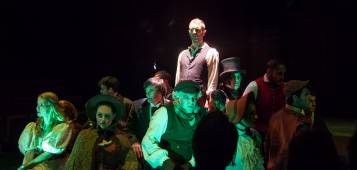 In the meantime, L.A. audiences can marvel how Kristin Towers-Rowles’ ingenious direction, Douglas Ladnier and Alison England’s world-class Sweeney and Mrs. Lovett, and an all-around terrific supporting cast have taken a great big Broadway show and scaled it down to small-stage proportions while maintaining the muscle and might that have made Sweeney Todd a contemporary classic.
In the meantime, L.A. audiences can marvel how Kristin Towers-Rowles’ ingenious direction, Douglas Ladnier and Alison England’s world-class Sweeney and Mrs. Lovett, and an all-around terrific supporting cast have taken a great big Broadway show and scaled it down to small-stage proportions while maintaining the muscle and might that have made Sweeney Todd a contemporary classic.
Based on the real-life tale of the infamous Demon Barber of Fleet Street, reputed to have murdered 160 individuals before being executed by hanging in 1801, Sweeney Todd The Musical (with book by Wheeler from an adaptation by Christopher Bond) introduces us to the former Benjamin Barker (Douglas Ladnier), falsely convicted of murder and shipped off for a decade and a half of servitude in Australia.
Now, his fifteen-year sentence completed, barber Barker has returned to London, bent on getting revenge on the judge who trumped up charges against him so as to have Barker’s wife for himself. To his horror, Barker learns that Lucy is out of the picture and that evil Judge Turpin (Chuck McCollum) has set his sights on the barber’s beautiful blonde daughter Johanna (Devon Davidson).
 A chance meeting with Mrs. Nellie Lovett (Alison England), the maker of “the worst pies in London,” leads first to the restoration of Sweeney’s razors, then to the devilishly inspired idea of stuffing said pies with human meat.
A chance meeting with Mrs. Nellie Lovett (Alison England), the maker of “the worst pies in London,” leads first to the restoration of Sweeney’s razors, then to the devilishly inspired idea of stuffing said pies with human meat.
In no time at all, Mrs. Lovett is running the most popular pie shop in London, with the rechristened “Sweeney Todd” using her upstairs room as his tonsorial parlor, where the necks of his hapless customers get sliced open by Sweeney’s deadly straight-edge razor.
Sweeney now begins a killing spree with Judge Turpin as his ultimate goal. As for the problem of how to get rid of the bodies, he and Mrs. Lovett come up with a solution to both their problems. No longer will she be selling “The Worst Pies In London” nor will Sweeney have to worry about corpse disposal. From now on, her confections will be filled with “A Little Priest,” or perhaps a little tinker, or a little butler, or a little locksmith.
Meanwhile, Sweeney and Anthony Hope (Alxander Jon), the sailor he met on his ocean journey back from Australia, attempt to free the barber’s now grown daughter from the clutches (and matrimonial plans) of the evil Judge Turpin and his accomplice in crime Beadle Bamford (Craig McEldowney).
 Also figuring in The Tale Of Sweeney Todd are Italian-accented con-artist Adolfo Pirelli (Mark Rohner), whose “Miracle Elixir” Sweeney exposes as the hoax it is before bumping him off; Tobias Ragg (Matt Steele), Pirelli’s sweet but simple-minded (and now unemployed) assistant, who is soon hired by Todd and Lovett to assist in her pie shop; and a nameless, demented Beggar Woman (Kendra Munger), in whom Sweeney’s face sparks some distant glimmer of recognition.
Also figuring in The Tale Of Sweeney Todd are Italian-accented con-artist Adolfo Pirelli (Mark Rohner), whose “Miracle Elixir” Sweeney exposes as the hoax it is before bumping him off; Tobias Ragg (Matt Steele), Pirelli’s sweet but simple-minded (and now unemployed) assistant, who is soon hired by Todd and Lovett to assist in her pie shop; and a nameless, demented Beggar Woman (Kendra Munger), in whom Sweeney’s face sparks some distant glimmer of recognition.
 Sweeney Todd The Musical features Sondheim in his darkest mode, his melodies and rhythms among the most complex he has written, though there are several simply beautiful (and beautifully simple) songs, most notably “Johanna” and “Not While I’m Around.” There are also comic relief numbers like “Pirelli’s Miracle Elixir,” “A Little Priest,” and “By The Sea” to brighten the gloom, at least temporarily. Still, it’s the murky darkness of “City On Fire!” and “The Ballad Of Sweeney Todd” and that most epitomize the demon barber’s black, black heart.
Sweeney Todd The Musical features Sondheim in his darkest mode, his melodies and rhythms among the most complex he has written, though there are several simply beautiful (and beautifully simple) songs, most notably “Johanna” and “Not While I’m Around.” There are also comic relief numbers like “Pirelli’s Miracle Elixir,” “A Little Priest,” and “By The Sea” to brighten the gloom, at least temporarily. Still, it’s the murky darkness of “City On Fire!” and “The Ballad Of Sweeney Todd” and that most epitomize the demon barber’s black, black heart.
John Doyle’s 2005 Broadway revival (the one in which the entire cast doubled as its onstage orchestra) re-imagined Sweeney Todd “as told by” patients of the insane asylum to which the musical’s sole survivor had been sent.
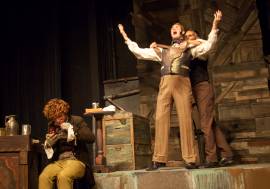 Though director Towers-Rowles is more faithful to the Sondheim-Wheeler original than Doyle, including the restoration of a number of often cut sequences, her “director’s concept” is equally inspired. Is it memory? Was it all a drug-induced dream? I’ll leave it to you to decide.
Though director Towers-Rowles is more faithful to the Sondheim-Wheeler original than Doyle, including the restoration of a number of often cut sequences, her “director’s concept” is equally inspired. Is it memory? Was it all a drug-induced dream? I’ll leave it to you to decide.
Suffice it to say that this excitingly original take on Sweeney gives its final “Ballad Of Sweeney Todd” reprise a gasp-worthy twist that thrilled this reviewer, and if you know Sweeney Todd as well as I do, it will thrill you too.
As the years have passed since Sweeney Todd’s Broadway debut, the musical’s title character has tended (as have King Arthurs, Harold Hills, and Henry Higginses) to get cast a decade—or or two or three—older than originally conceived (and originated back in 1979 by a then 39-year-old Len Cariou).
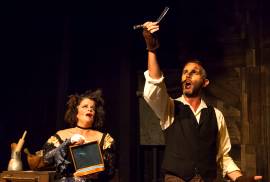 Casting tall, lean, seductive 40ish Ladnier as Sweeney adds new shadings of lust to Mrs. Lovett’s decades-long infatuation. That Ladnier is an imposing stage presence, a powerful actor, and sings the role as richly and resonantly as it can possibly be sung makes him as fine a choice for the role as anyone could wish for.
Casting tall, lean, seductive 40ish Ladnier as Sweeney adds new shadings of lust to Mrs. Lovett’s decades-long infatuation. That Ladnier is an imposing stage presence, a powerful actor, and sings the role as richly and resonantly as it can possibly be sung makes him as fine a choice for the role as anyone could wish for.
Equal perfection is England’s divinely dotty Mrs. Lovett, wildly, crazily over-the-top and yet real as can be. England’s comedic chops are as finely honed as they get, and though Sondheim’s melodies don’t take her to the stratosphere she reached as Zombina in Zombies From The Beyond, her vocal take on the baker lady is one to be savored.
Not surprisingly, the dynamic duo’s duets of “A Little Priest” and “By The Sea” prove showstoppers of the first order.

 Supporting performances offer audiences one featured gem after another, from the gorgeous-to-look-at, gorgeous-to-listen-to boy/girl ingénue pairing of Davidson and Jon as Johanna and Anthony, to McCollum’s terrifically twisted take on Judge Turpin, to McEldowney’s eminently watchable and gloriously sung reinvention of Beadle Bamford.
Supporting performances offer audiences one featured gem after another, from the gorgeous-to-look-at, gorgeous-to-listen-to boy/girl ingénue pairing of Davidson and Jon as Johanna and Anthony, to McCollum’s terrifically twisted take on Judge Turpin, to McEldowney’s eminently watchable and gloriously sung reinvention of Beadle Bamford.
Munger makes the utmost of every loony Beggar Woman moment, aided and abetted by Towers-Rowles’ director’s concept, one which could only be improved by keeping Munger more visibly attentive throughout.
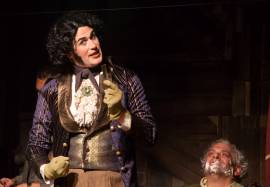 Most scene-stealing of all are the extravagantly coiffed Rohner as a fabulously flamboyant Pirelli, and the curly-mopped Steele, who adds his own quirky touches to Tobias, and both are absolutely superb singers to boot.
Most scene-stealing of all are the extravagantly coiffed Rohner as a fabulously flamboyant Pirelli, and the curly-mopped Steele, who adds his own quirky touches to Tobias, and both are absolutely superb singers to boot.
 Ensemble members Antonio Ardolino, Michael D’Elia, Melinda Ehrlich, Marty Feldman, Lena Gwendolyn Hill, Rachel Hirshee, Kelly Meyersfield, Hector S. Quintana, and Anibal Silveyra are not only all quite marvelous, eight of them understudy major roles, with guaranteed performances, so it’s likely that you’ll be seeing one of the eight stepping into someone’s shoes when you attend.
Ensemble members Antonio Ardolino, Michael D’Elia, Melinda Ehrlich, Marty Feldman, Lena Gwendolyn Hill, Rachel Hirshee, Kelly Meyersfield, Hector S. Quintana, and Anibal Silveyra are not only all quite marvelous, eight of them understudy major roles, with guaranteed performances, so it’s likely that you’ll be seeing one of the eight stepping into someone’s shoes when you attend.
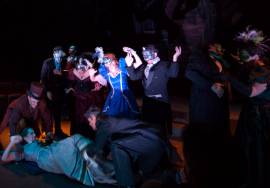 Towers-Rowles’ musical staging and Samantha Marie’s choreography of “The Ballad of Sweeney Todd” and “God, That’s Good” both merit cheers as does the inspired flashback sequence that backs up “The Barber And His Wife.”
Towers-Rowles’ musical staging and Samantha Marie’s choreography of “The Ballad of Sweeney Todd” and “God, That’s Good” both merit cheers as does the inspired flashback sequence that backs up “The Barber And His Wife.”
Musical director Joe Lawrence scores high marks for cast vocals and harmonies, and provides virtually nonstop (and mostly top-notch) musical accompaniment on piano.
Scenic designer Erik Austin’s set is simple but does the trick, and Sweeney’s barber’s chair earns the laughs that we expect from a first-class Sweeney Todd. Stage blood is eschewed in favor of blood-red lighting effects by lighting designer Marie, whose work is excellent throughout. Prop master Lester Wilson gets top marks as well. As for Michael Mullen’s period costumes, they once again steal the show, topped off by Debi Hernandez’s wonderful wig stylings.
Marie is stage manager. Stephanie Fredricks is assistant director.
If Actors’ Equity has its way, big-cast, big-scale, small-stage musicals with multiple AEA cast members will soon be a much-regretted thing of L.A.’s theatrical past, all the more reason to catch this swoon-worthy Sweeny while you can. We may never see its like again.
Monroe Forum at the El Portal Theatre, 5269 Lankershim Blvd., North Hollywood.
www.kelrikproductions.org
–Steven Stanley
April 10, 2015
Photos: Grettel Cortes Photography
Tags: El Portal Theatre, Los Angeles Theater Review, Stephen Sondheim



 Since 2007, Steven Stanley's StageSceneLA.com has spotlighted the best in Southern California theater via reviews, interviews, and its annual StageSceneLA Scenies.
Since 2007, Steven Stanley's StageSceneLA.com has spotlighted the best in Southern California theater via reviews, interviews, and its annual StageSceneLA Scenies.







 COPYRIGHT 2025 STEVEN STANLEY :: DESIGN BY
COPYRIGHT 2025 STEVEN STANLEY :: DESIGN BY